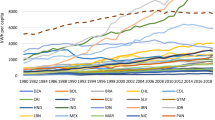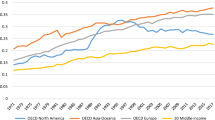Abstract
This paper examines the pattern of convergence in electricity intensity in a sample of 79 countries. We apply the residual augmented least squares regression to the convergence of energy intensity. This method has been used in the convergence of per capita energy consumption but not convergence of energy intensity. Furthermore, in contrast to the previous studies which mainly used the conventional beta convergence approach to examine conditional convergence, we use a beta convergence method that is capable of identifying the actual number of countries that contribute to conditional convergence. The sigma and gamma convergences of electricity intensity are also examined. In addition to the full sample of countries, we also examine convergence in African countries, Asian and Oceanic countries, American countries and European countries, separately. Convergences in OECD and non-OECD countries are also examined, separately. In the full sample, the results show convergence exists in 54% of the countries in the total sample. There is convergence in 65% of the African countries, 61% of the American countries, 43% of the Asian and Oceanic countries and 33% of the European countries. In terms of the regional classification, it is also observed that convergence exists for 58% of the non-OECD countries and 31% of the OECD countries. There is evidence for sigma convergence in all the blocs with the exception of European and non-OECD countries. With the exception of African countries, there is evidence for gamma convergence in all the countries and the various blocs. The policy implications of the results are discussed.







Similar content being viewed by others
Notes
Decreasing energy intensity (i.e. the ratio of energy input to economic activity) is vital in combating the current concerns about greenhouse gas emissions and ensuring energy security.
Another approach is the club clustering convergence method, which has the ability of capturing the comparative convergence of cross-sectional midpoints.
We are aware that several authors have used the method to evaluate the convergence of relative per capita energy consumption. However, no previous studies on energy intensity has adopted this method.
Another related area that has been studied in the literature is energy productivity. Due to space concern, we only concentrate on the convergence of energy consumption and intensity (Ulucak and Apergis 2018).
Some of these authors have utilised several methods, but we only review the methods that are closely related to ours.
Algeria, Argentina, Australia, Austria, Bangladesh, Belgium, Bolivia, Brazil, Cameroon, Canada, Chile, China, Colombia, Congo Democratic Republic, Congo Republic, Costa Rica, Cote , Cuba, Denmark, Dominican Republic, Ecuador, Egypt, El Salvador, Finland, France, Gabon, Germany, Ghana, Greece, Guatemala, Honduras, Iceland, India, Indonesia, Iran, Iraq, Ireland, Israel, Italy, Jamaica, Japan, Kenya, Korea, Luxembourg., Malaysia, Malta, Mexico, Morocco, Myanmar, Nepal, Netherlands, Nicaragua, Nigeria, Norway, Oman, Pakistan, Panama, Paraguay, Peru, Philippines, Portugal, Saudi Arabia, Senegal, Singapore, South Africa, Spain, Sri Lanka, Sudan, Sweden, Thailand, Trinidad and Tobago, Tunisia, Turkey, United Kingdom, United States, Uruguay, Venezuela, Zambia and Zimbabwe.
Electricity consumption includes the production of power plants and combined heat and power plants less transmission, distribution and transformation losses and own use by heat and power plants.
In the process of data extraction, we observe that some countries have consistent data for only one of the two variables. For instance, while countries such as Bahamas, Burundi and Puerto Rico have consistent data for real GDP per capita but not electricity consumption per capita, Albania, Mozambique and Poland have consistent data for electricity consumption per capita but not real GDP per capita. We ignore all the countries that failed to produce consistent datasets for the two variables.
Although Liddle (2009) conducted an exercise that normalises an intercept and trend to the log of electricity series, the method was not used to identify convergence as adopted in our study.
We have used the structural breaks resulting from the RALS test. The only difference we observed for structural breaks between LM and RALS test is the case of Indonesia. According to the LM test, there are two structural breaks for Indonesia, which are 1994 and 2000.
For the purpose of this test, we only picked the intercept, linear or the dummy variable that the t-statistic suggests that it is significant, which is consistent with the work of Galvao and Reis Gomes (2007). Hence, we have not reported the intercept terms and the two dummies that represent(s) two breaks in the intercepts as none of the terms are individually significant according to the t-statistics in Cameroon, Iraq and Israel.
According to the LM test, there are two structural breaks for Congo Democratic Republic, which are 1986 and 1998.
According to the LM test, there is only one break for Ireland, which is 1997.
For details on Zimbabwe, see footnote 10.
For details on Iraq, see footnote 10.
According to the LM test, there are two structural breaks for Algeria, which are 1981 and 2005.
According to the LM test, there are two structural breaks for Austria, which are 1990 and 2001, and there is structural break in Ireland, which is in 1997.
For details on Iraq, see footnote 10.
We have also estimated the total sample and the adopted blocs with the traditional beta convergence and the results provide evidence for convergence. We do not report the results because of space. It is available from the author upon request.
We cannot do a direct comparison with the results of Liddle (2009) because out of the 22 countries adopted in his dataset, we do not have the required data for New Zealand and Switzerland.
References
Abid M, Alimi M (2018) Stochastic convergence in US disaggregated gas consumption at the sector level. Journal of Natural Gas Science and Engineering 60:1–37
Aldy JE (2007) Divergence in state-level per capita carbon dioxide emissions. Land Econ 83(3):353–369
Armey LE, Hosman L (2016) The centrality of electricity to ICT use in low-income countries. Telecommun Policy 40(7):617–627
Barro RJ, Sala-i-Martin X, Blanchard OJ, Hall RE (1991) Convergence across states and regions. Brook Pap Econ Act 1991:107–182
Boyle GE, McCarthy TG (1997) A simple measure of b-convergence. Oxf Bull Econ Stat 59(2):0305–9049
Burnett JW, Madariaga J (2017) The convergence of US state-level energy intensity. Energy Econ 62:357–370
Carlino GA, Mills LO (1993) Are US regional incomes converging? A time series analysis. J Monet Econ 32(2):335–346
Csereklyei Z, Stern DI (2015) Global energy use: decoupling or convergence? Energy Econ 51:633–641
Dawson JW, Strazicich MC (2010) Time-series tests of income convergence with two structural breaks: evidence from 29 countries. Appl Econ Lett 17(9):909–912
Ezcurra R (2007) Distribution dynamics of energy intensities: a cross-country analysis. Energy Policy 35(10):5254–5259
Fallahi F, Voia MC (2015) Convergence and persistence in per capita energy use among OECD countries: Revisited using confidence intervals. Energy Econ 52: 246–253
Friedman M (1992) Do old fallacies ever die? J Econ Lit 30:2129–2132
Galvao AF, Reis Gomes FA (2007) Convergence or divergence in Latin America? A time series analysis. Appl Econ 39(11):1353–1360
Hajko V (2014) The energy intensity convergence in the transport sector. Procedia Economics and Finance 12:199–205
Henry M, Kneller R, Milner C (2009) Trade, technology transfer and national efficiency in developing countries. Eur Econ Rev 53(2):237–254
Herrerias MJ, Liu G (2013) Electricity intensity across Chinese provinces: new evidence on convergence and threshold effects. Energy Econ 36:268–276
Le Pen Y, Sévi B (2010) On the non-convergence of energy intensities: evidence from a pair-wise econometric approach. Ecol Econ 69(3):641–650
Le TH, Chang Y, Park D (2017) Energy demand convergence in APEC: An empirical analysis. Energy Econ 65:32–41
Lee J, Strazicich MC (2003) Minimum Lagrange multiplier unit root test with two structural breaks. Rev Econ Stat 85(4):1082–1089
Lee J, Strazicich MC, Meng M (2012) Two-step LM unit root tests with trend-breaks. J Stat Econ Methods 1(2):81–107
Liddle B (2009) Electricity intensity convergence in IEA/OECD countries: aggregate and sectoral analysis. Energy Policy 37(4):1470–1478
Liddle B (2010) Revisiting world energy intensity convergence for regional differences. Appl Energy 87(10):3218–3225
Markandya A, Pedroso-Galinato S, Streimikiene D (2006) Energy intensity in transition economies: is there convergence towards the EU average? Energy Econ 28(1):121–145
Meng M, Payne JE, Lee J (2013) Convergence in per capita energy use among OECD countries. Energy Econ 36:536–545
Meng M, Im KS, Lee J, Tieslau MA (2014) More powerful LM unit root tests with non-normal errors. In: Sickles RC, Horrace WC (eds) Festschrift in Honor of Peter Schmidt. Springer, New York, pp 343–357
Mishra V, Smyth R (2017) Conditional convergence in Australia’s energy consumption at the sector level. Energy Econ 62:396–403
Mulder P, de Groot HL (2012) Structural change and convergence of energy intensity across OECD countries, 1970–2005. Energy Econ 34(6):1910–1921
Nieswiadomy ML, Strazicich MC (2004) Are political freedoms converging? Econ Inq 42(2):323–340
Ozcan B, Ulucak R, Dogan E (2019) Analyzing long lasting effects of environmental policies: evidence from low, middle and high income economies. Sustainable Cities and Society 44:130–143
Payne JE, Vizek M, Lee J (2017) Stochastic convergence in per capita fossil fuel consumption in US states. Energy Econ 62:382–395
Pesaran MH (2007) A pair-wise approach to testing for output and growth convergence. J Econ 138(1):312–355
Quah D (1993) Galton’s fallacy and tests of the convergence hypothesis. Scand J Econ 95:427–443
Solarin SA, Lean HH (2016) Are fluctuations in oil consumption permanent or transitory? Evidence from linear and nonlinear unit root tests. Energy Policy 88:262–270
Solarin SA, Lean HH (2018) Conditional convergence in energy consumption per capita of OPEC member countries: evidence from non-linearity tests. OPEC Energy Review 42(3):199–211
Ulucak R, Apergis N (2018) Does convergence really matter for the environment? An application based on club convergence and on the ecological footprint concept for the EU countries. Environ Sci Pol 80:21–27
World Bank (2017). World Development Indicators. (2016) Retrieved from: www.data.worldbank.org. Accessed 26 Dec 2017
Xin-gang Z, Yuan-feng Z, Yan-bin L (2019) The spillovers of foreign direct investment and the convergence of energy intensity. J Clean Prod 206(1):611–621
Zhang W, Pan X, Yan Y, Pan X (2017a) Convergence analysis of regional energy efficiency in china based on large-dimensional panel data model. J Clean Prod 142:801–808
Zhang C, Zhou K, Yang S, Shao Z (2017b) On electricity consumption and economic growth in China. Renew Sust Energ Rev 76:353–368
Author information
Authors and Affiliations
Corresponding author
Additional information
Responsible editor: Philippe Garrigues
Publisher’s note
Springer Nature remains neutral with regard to jurisdictional claims in published maps and institutional affiliations.
Rights and permissions
About this article
Cite this article
Solarin, S.A. Parametric and non-parametric convergence analysis of electricity intensity in developed and developing countries. Environ Sci Pollut Res 26, 8552–8574 (2019). https://doi.org/10.1007/s11356-019-04225-y
Received:
Accepted:
Published:
Issue Date:
DOI: https://doi.org/10.1007/s11356-019-04225-y




